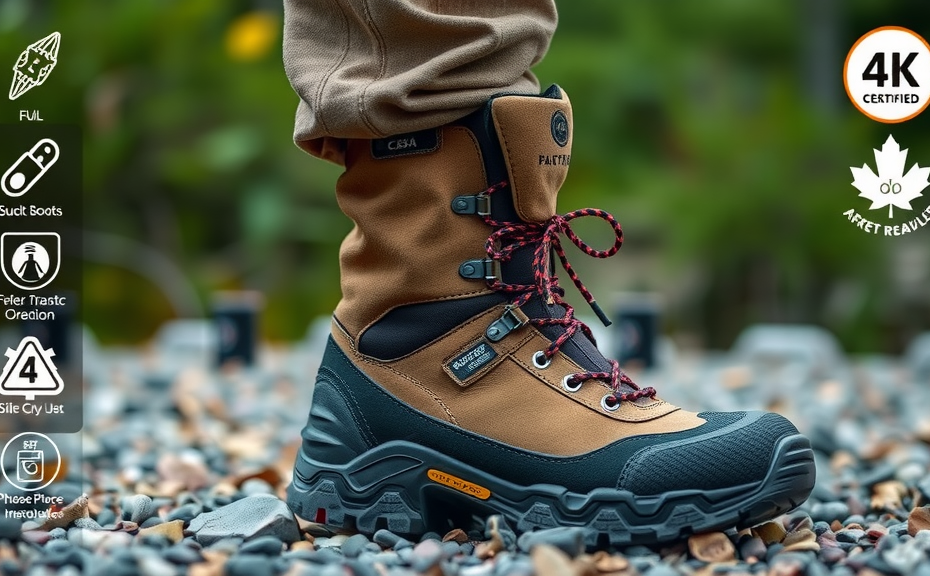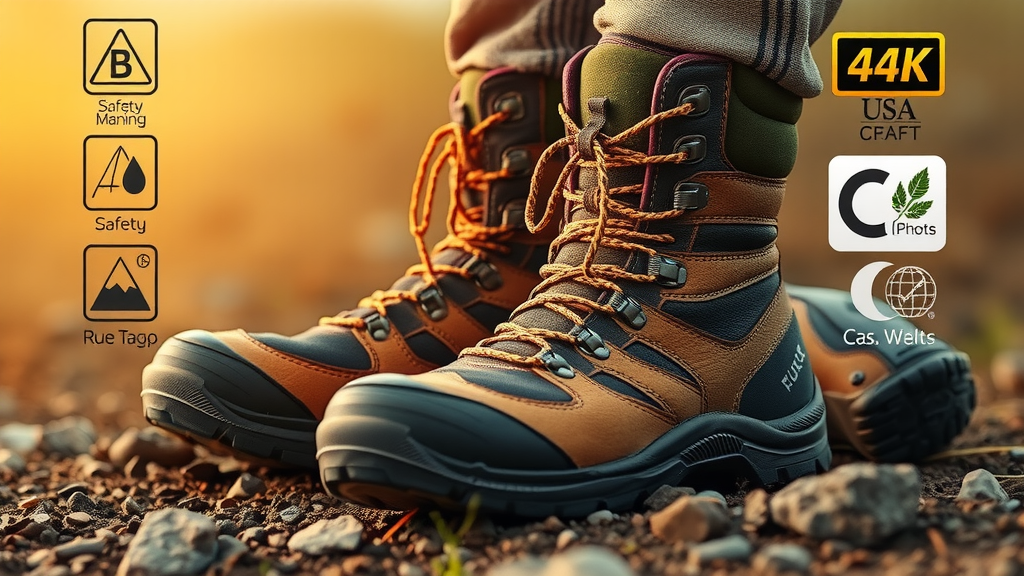Modern footwear solutions designed for industrial environments are evolving, with options available that prioritize safety without the weight of traditional materials. Protective shoes using advanced non-metal constructions are gaining popularity among workers seeking comfort alongside durability.
A common misconception is that certification from the Canadian Standards Association only applies to steel toe designs; however, this perception overlooks the broader range of CSA-approved alternatives available.
The Canadian Standards Association establishes strict guidelines to assess the safety features of work footwear, including models equipped with composite toe protections.
Their thorough certification process requires all aspects of safety boots to undergo rigorous evaluations to ensure they meet necessary standards. Interestingly, many individuals remain unaware of the various protective capabilities offered through CSA-approved composite options, which significantly contribute to minimizing injury risks in work footwear, such as safety boots and protective shoes, that are designed to protect against hazards while providing comfort and support.
Are Composite Toe Boots CSA Approved
Not all composite toe footwear is certified by safety standards organizations, which can lead to misconceptions about their protective capabilities. The Canadian Standards Association (CSA) establishes criteria for safety shoes to ensure adequate protection against workplace hazards.
These standards address various aspects, including slip-resistant properties and electrical hazard protection.
Composite toe designs often incorporate lightweight materials that deliver shock resistance and thermal insulation.
The absence of CSA approval in certain models highlights the importance of verifying compliance before purchase. Some options may also include features such as waterproof materials or durable construction, contributing to their overall safety profile.
Checking for proper certification ensures reliable protection for individuals in hazardous work environments.
Understanding Composite Toe Safety Standards
Footwear constructed with advanced materials prioritizes safety and comfort in hazardous environments. These nonmetallic designs are engineered to provide impact protection without the added weight typically associated with steel caps.
Various organizations, such as ASTM International and CSA Group, establish rigorous safety standards for industrial footwear, ensuring that boots meet specific criteria including impact resistance, compression, and puncture resistance.
Compliance with these benchmarks is crucial for protecting users from injury and shielding manufacturers from liability issues.
Many of these boots also incorporate breathable materials and shock-absorbent technology, enhancing the comfort fit required for prolonged wear in rugged conditions.
Advanced Footwear
- Nonmetallic designs offer impact protection while reducing weight compared to traditional steel-capped boots.
- ASTM International and CSA Group set safety standards that ensure footwear meets criteria like impact resistance and puncture resistance.
- Compliance with safety benchmarks protects users from injuries and manufacturers from liability issues.
- Many advanced boots feature breathable materials and shock-absorbent technology for enhanced comfort during prolonged wear.
Benefits Of CSA Approved Footwear
Footwear designed for specific work conditions can significantly enhance safety and efficiency in various environments. CSA approved models prioritize occupational safety by offering features such as impact resistance and puncture protection, making them beneficial for workers facing hazardous situations.
Slip-resistant soles play an important role as well, effectively decreasing the likelihood of falls, especially where spills are common.
Many options also include insulated boots, ensuring warmth and comfort during colder months without compromising protective capabilities.
Investing in these boots demonstrates an employer’s commitment to the well-being of their workforce while maintaining compliance with industry standards. Following this exploration of the benefits, it is important to examine how CSA criteria relate to alternative safety standards, particularly when comparing steel toe versus composite toe footwear.
Comparing Steel Toe Vs Composite Toe
Analyzing the differences between protective footwear types reveals distinct advantages, particularly related to safety and comfort on the job. Steel-reinforced models offer significant durability, designed to withstand heavy impacts and provide robust toe protection.
Conversely, boots made with non-metal materials are lighter and do not conduct electricity, making them ideal for environments with electrical hazards.
- Material Composition
- Steel-reinforced boots incorporate a robust cap for substantial impact defense, vital in construction settings.
- Non-metal models utilize materials such as Kevlar, carbon fiber, or plastic, presenting a lighter option that often features ergonomic design. Boots designed for women with oil-resistant materials, reinforced toe protection, high safety ratings, ergonomic design, and antifatigue features ensure optimal weight and comfort for long hours of wear.
Footwear Type Advantages Steel-reinforced Boots High durability and robust toe protection against heavy impacts Non-metal Boots Lightweight, non-conductive, ideal for electrical hazard environments Women’s Safety Boots Oil-resistant, ergonomic design, reinforced toe protection, antifatigue features What Makes Boots CSA Certified
Safety standards in footwear are vital for worker protection across various industries. Overview of CSA Certification
Canadian Standards Association, known as CSA, is instrumental in setting these rigorous standards for boots, offering guidelines that ensure manufacturers adhere to safety protocols.This compliance is not just a regulatory requirement but also assures consumers about the reliability of their outdoor work gear.
Testing Requirements
To attain CSA certification, boots must undergo extensive testing.These tests evaluate impact resistance, compression resistance, and electric shock resistance, each critical in guaranteeing the safety of those working in potentially hazardous environments.
The stringent assessment helps ensure that tactical boots can withstand demanding conditions. A blend of steel and composite materials is commonly employed in the design of certified boots, enhancing their durability and protective capabilities, making them suitable for heavy-duty tactical boots that provide optimal orthopedic support, chemical resistance, and traction soles for demanding outdoor work gear.
Key Features Of Protective Shoes
Safety footwear is designed with multiple functionalities to promote both protection and comfort during use. A longlasting upper material is integral to these shoes, frequently crafted from leather or synthetic composites.
These materials effectively resist wear and various environmental hazards.
Unique Fact: Some synthetic compounds enhance breathability while maintaining waterproof characteristics, thus providing a high level of comfort.Impact resistance is another key feature, with toe protection supplied by steel, aluminum, or composite materials to guard against falling objects.
Unique Fact: Composite toe caps are lightweight and non-conductive, making them particularly well-suited for electrical work environments.The composition of the sole is also significant; slip-resistant soles ensure traction, while certain designs incorporate a flexible sole and anti-fatigue properties for individuals who stand for extended periods. The footwear features high visibility, a long-lasting flexible sole, complies with safety standards, includes a cushioned insole for comfort, and has adjustable straps for a secure fit.
Safety Footwear
- Safety footwear is made from durable materials like leather and synthetic composites to resist wear and environmental hazards.
- Composite toe caps are lightweight and non-conductive, making them ideal for use in electrical work environments.
- Slip-resistant soles provide traction, while flexible soles with anti-fatigue properties enhance comfort for those who stand for long periods.
- Safety footwear features high visibility and adjustable straps for a secure fit, ensuring compliance with safety standards.
The Importance Of Safety Ratings
Footwear designed for safety plays a significant role in minimizing workplace hazards. Safety ratings serve as a guide to assess how well a shoe can withstand various risks, including slips, punctures, and impacts.
Different countries adhere to specific standards, with organizations like ASTM in the United States and ISO internationally establishing classifications based on safety features.
These standardized ratings ensure that users can select footwear designed with appropriate impact resistance and high ankle support.
Weatherproof materials can enhance protection, particularly in outdoor settings where conditions can be unpredictable. Choosing footwear that meets these ratings not only helps reduce the risk of injury but also promotes comfort technology that caters to long hours on the job.
Workers often find it beneficial to grasp these standards, as this knowledge empowers them to make informed choices while ensuring safety remains a priority alongside comfort. Transitioning from understanding key features of protective shoes, it’s vital to consider the benefits of weatherproof, multipurpose footwear that incorporates comfort technology, impact resistance, high ankle support, and moisture-wicking capabilities.
Choosing The Right Work Footwear
Selecting proper footwear is fundamental to maintaining safety and efficiency in the workplace. Different job environments necessitate various forms of protection and performance.
Footwear designed with a reinforced heel can significantly enhance stability while offering protection against potential hazards.
Choosing options that are field tested guarantees that they are capable of withstanding the demands of rigorous job tasks.
Shoes constructed from durable materials not only resist wear but also prolong the lifespan of the footwear, thereby reducing the need for frequent replacements. Prioritizing selections that are job site approved can further ensure compliance with industry safety standards.
Investing in high-quality work footwear ultimately contributes to increased productivity and protection against workplace injuries, making a well-informed choice crucial for safety and comfort throughout each workday.

